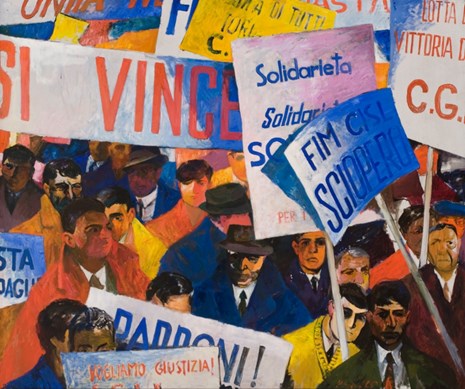The young Vincentas Gečas painted Demonstration by the Unemployed in 1965 from sketches and impressions gathered during an internship he had spent in Italy two years previously. This internship was an exceptional fact, not only in Gečas' life. In the mid-1960s, any trip abroad by a Soviet citizen, even a short trip, was an important experience, of which most residents of the Lithuanian SSR were deprived. Therefore, a long ten-month stay in Italy was an extraordinary event in the whole art life of Lithuania.
The artistic atmosphere in Italy at the time of Gečas' visit was socially engaged and overtly leftist. Galleries often showed political art by Renato Guttuso and other Italian artists associated with Neorealism.
In Italy Gečas produced multiple sketches in all genres, and later painted many spectacular landscapes, still-lifes and portraits; but his fame rests largely on his publicist paintings. Two such paintings,Demonstration by theUnemployedandThe Crash, are exhibited in this hall.
The painter produced two versions ofDemonstration.The first one was achromatic, just black and white, and therefore photographic or cinematographic in character. By contrast, the second one, presented in this hall, is almost an eyesore, because of its blue, orange and yellow colour combination. The image evokes media reportage. Its composition, filled with lettering from political banners and protesters' faces, sharpened by a black countour, reminds us of a newspaper photograph. The informal sketchy painting and the fragmentary, somewhat chaotic composition distinguishes Gečas' picture from other political works of art produced by Lithuanian artists at the time.



